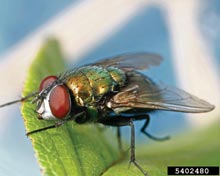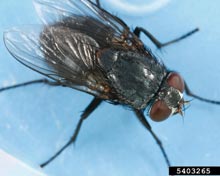
Joseph Berger

Joseph Berger
Blow Flies
General Descriptions
Blow flies are named because their larvae develop inside the bodies of dead animals, causing the carrion to
have a bloated appearance. They also are attracted to garbage. Blow flies are about one-fourth of an inch long
or slightly larger with shiny blue or green color resembling colored glass bottles, though some species are shiny
black or bronze. They have been called “bottle flies” because of this. Large numbers of blow flies indoors
usually indicates the presence of a dead animal such as a mouse or bird inside the structure.
General Control
Eliminate fly breeding sites by locating the attracting material - carrion and/or garbage for blow flies. Proper
inspection and cleaning of dumpster and trash areas can help reduce the number of blow flies attracted to the
site. Barriers, such as screening not less than 16-mesh, and tight-fitting, self-closing doors that are kept closed
when not in use, help reduce the number of flies inside structures.
In addition to fly swatting, mechanical fly control includes trapping with the use of sticky fly paper and ultraviolet light traps. To be effective, light traps must be properly placed. They should be placed where they cannot be seen from outside the building, no more than 5 feet above the floor, and away from competing light sources and food preparation areas.
While the use of pesticides is usually not the best means of managing filth fly problems, sometimes chemical control can be a valuable component of an integrated fly management program. However, this type of control often provides only temporary relief and cannot be relied upon to eliminate the problem.









